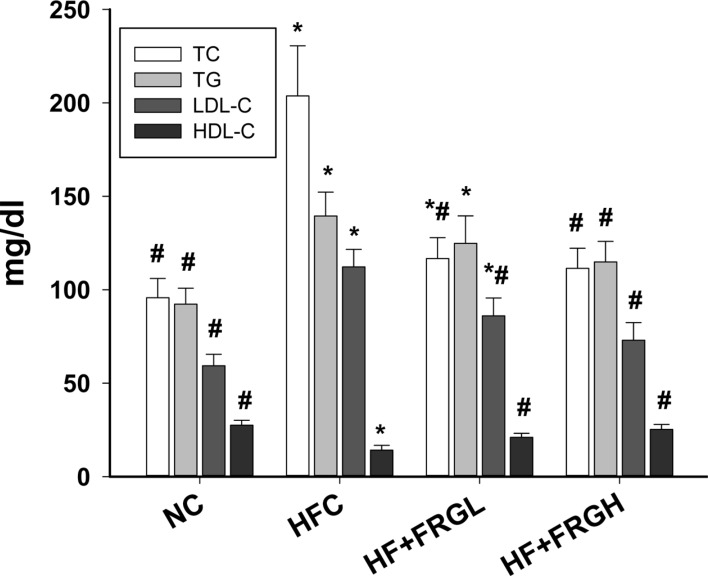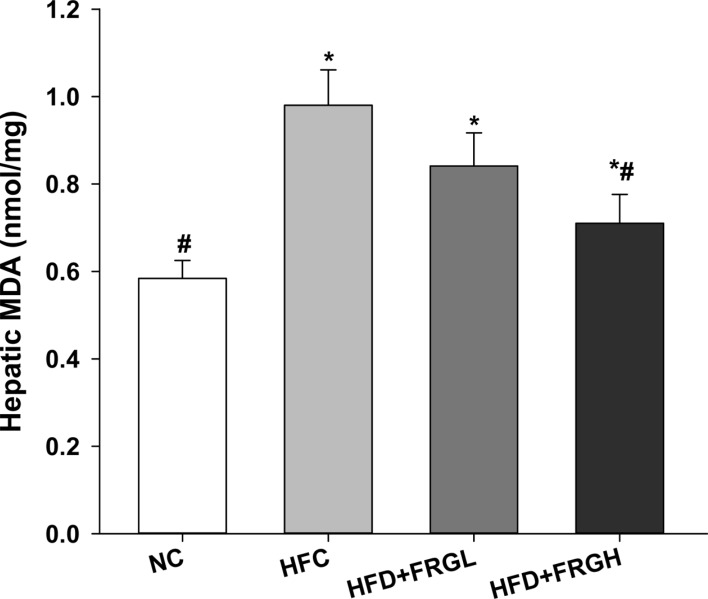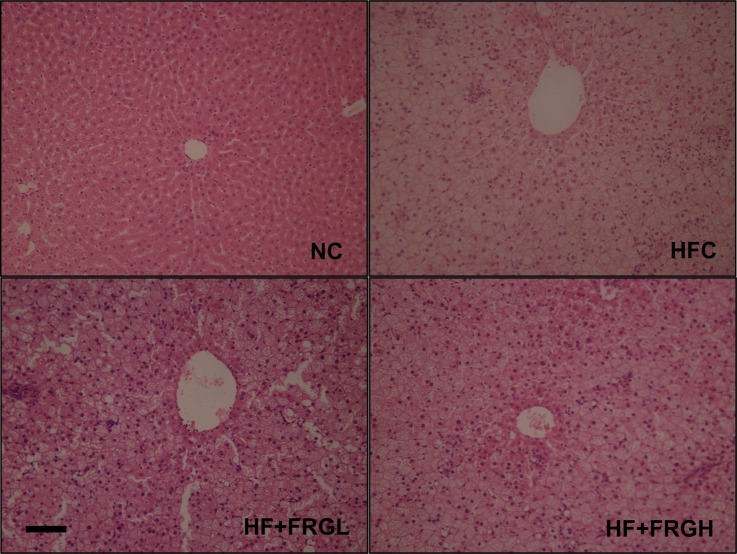Lab Anim Res.
2016 Dec;32(4):217-223. 10.5625/lar.2016.32.4.217.
Antioxidant and hepatoprotective effects of fermented red ginseng against high fat diet-induced hyperlipidemia in rats
- Affiliations
-
- 1College of Veterinary Medicine, Kyungpook National University, Daegu, 41566, Korea. kskim728@knu.ac.kr
- KMID: 2362913
- DOI: http://doi.org/10.5625/lar.2016.32.4.217
Abstract
- This study was performed to investigate the antioxidant and hepatoprotective effects of fermented red ginseng (Panax ginseng C.A. Meyer; FRG) on high-fat diet-induced hyperlipidemia in rats. Sprague-Dawley rats were divided into four groups of seven: normal control, NC; high-fat diet control, HFC; high-fat diet-0.5% FRG, HF-FRGL; and high-fat diet-1% FRG, HF-FRGH. All rats were fed a high-fat diet for eight weeks, except those in the NC group, while rats in the FRG treatment groups received drinking water containing 0.5% or 1% FRG. After eight weeks of treatment, levels of alanine aminotransferase (ALT), aspartate aminotransferase (AST), total cholesterol (TC), triglycerides (TG), low-density lipoprotein-cholesterol (LDL-C), and high-density lipoprotein-cholesterol (HDL-C) in the serum were measured. The concentration of the oxidative stress marker malondialdehyde (MDA), and activity of antioxidant enzymes including superoxide dismutase (SOD), catalase (CAT), and glutathione peroxidase (GSH-Px) in rat liver were evaluated. Histological analysis of the liver was performed using hematoxylin and eosin. The high-fat diet markedly increased serum levels of ALT, AST, TC, TG, and LDL-C and hepatic MDA levels, while administration of FRG to the hyperlipidemic rats resulted in a significant decline in the levels of these parameters. Furthermore, the decline in the levels of serum HDL-C and hepatic SOD, CAT, and GSH-Px induced by the high-fat diet was attenuated by FRG treatment. In addition, histopathological analysis of liver sections suggested that FRG treatment also provided protection against liver damage. These results suggested that FRG improved lipid profiles, inhibited lipid peroxidation, and played a protective role against liver injury in hyperlipidemic rats.
Keyword
MeSH Terms
-
Alanine Transaminase
Animals
Antioxidants
Aspartate Aminotransferases
Catalase
Cats
Cholesterol
Diet, High-Fat
Drinking Water
Eosine Yellowish-(YS)
Glutathione Peroxidase
Hematoxylin
Hyperlipidemias*
Lipid Peroxidation
Liver
Malondialdehyde
Oxidative Stress
Panax*
Rats*
Rats, Sprague-Dawley
Superoxide Dismutase
Triglycerides
Alanine Transaminase
Antioxidants
Aspartate Aminotransferases
Catalase
Cholesterol
Drinking Water
Eosine Yellowish-(YS)
Glutathione Peroxidase
Hematoxylin
Malondialdehyde
Superoxide Dismutase
Triglycerides
Figure
Cited by 1 articles
-
Antioxidant and hepatoprotective effects of Korean ginseng extract GS-KG9 in a D-galactosamine-induced liver damage animal model
Yun Ho Jo, Hwan Lee, Myeong Hwan Oh, Gyeong Hee Lee, You Jin Lee, Ji Sun Lee, Min Jung Kim, Won Yong Kim, Jin Seong Kim, Dae Seok Yoo, Sang Won Cho, Seon Woo Cha, Mi Kyung Pyo
Nutr Res Pract. 2020;14(4):334-351. doi: 10.4162/nrp.2020.14.4.334.
Reference
-
1. Dhalla NS, Temsah RM, Netticadan T. Role of oxidative stress in cardiovascular diseases. J Hypertens. 2000; 18(6):655–673. PMID: 10872549.
Article2. Bertram C, Hass R. Cellular responses to reactive oxygen species-induced DNA damage and aging. Biol Chem. 2008; 389(3):211–220. PMID: 18208352.
Article3. Wang Y. Bulky DNA lesions induced by reactive oxygen species. Chem Res Toxicol. 2008; 21(2):276–281. PMID: 18189366.
Article4. Yang RL, Shi YH, Hao G, Li W, Le GW. Increasing Oxidative Stress with Progressive Hyperlipidemia in Human: Relation between Malondialdehyde and Atherogenic Index. J Clin Biochem Nutr. 2008; 43(3):154–158. PMID: 19015749.
Article5. Inzucchi SE. Oral antihyperglycemic therapy for type 2 diabetes: scientific review. JAMA. 2002; 287(3):360–372. PMID: 11790216.6. Kumari K, Augusti KT. Lipid lowering effect of S-methyl cysteine sulfoxide from Allium cepa Linn in high cholesterol diet fed rats. J Ethnopharmacol. 2007; 109(3):367–371. PMID: 16987625.
Article7. Son IS, Kim JH, Sohn HY, Son KH, Kim JS, Kwon CS. Antioxidative and hypolipidemic effects of diosgenin, a steroidal saponin of yam (Dioscorea spp.), on high-cholesterol fed rats. Biosci Biotechnol Biochem. 2007; 71(12):3063–3071. PMID: 18071250.
Article8. Attele AS, Wu JA, Yuan CS. Ginseng pharmacology: multiple constituents and multiple actions. Biochem Pharmacol. 1999; 58(11):1685–1693. PMID: 10571242.9. Kim JH. Cardiovascular Diseases and Panax ginseng: A Review on Molecular Mechanisms and Medical Applications. J Ginseng Res. 2012; 36(1):16–26. PMID: 23717100.
Article10. Yun SN, Moon SJ, Ko SK, Im BO, Chung SH. Wild ginseng prevents the onset of high-fat diet induced hyperglycemia and obesity in ICR mice. Arch Pharm Res. 2004; 27(7):790–796. PMID: 15357009.
Article11. Jung JW, Kang HR, Ji GE, Park MS, Song WJ, Kim MH, Kwon JW, Kim TW, Park HW, Cho SH, Min KU. Therapeutic effects of fermented red ginseng in allergic rhinitis: a randomized, double-blind, placebo-controlled study. Allergy Asthma Immunol Res. 2011; 3(2):103–110. PMID: 21461249.
Article12. Trinh HT, Han SJ, Kim SW, Lee YC, Kim DH. Bifidus fermentation increases hypolipidemic and hypoglycemic effects of red ginseng. J Microbiol Biotechnol. 2007; 17(7):1127–1133. PMID: 18051323.13. Kim HJ, Chae IG, Lee SG, Jeong HJ, Lee EJ, Lee IS. Effects of Fermented Red Ginseng Extracts on Hyperglycemia in Streptozotocin-induced Diabetic Rats. J Ginseng Res. 2010; 34:104–112.
Article14. Cha JY, Park JC, Ahn HY, Eom KE, Park BK, Jun BS, Lee CH, Cho YS. Effect of Monascus purpureus-Fermented Korean Red Ginseng Powder on the Serum Lipid Levels and Antioxidative Activity in Rats. J Korean Soc Food Sci Nutr. 2009; 38:1153–1160.
Article15. Draper HH, Hadley M. Malondialdehyde determination as index of lipid peroxidation. Methods Enzymol. 1990; 186:421–431. PMID: 2233309.16. Kim ST, Jang JH, Kwon JH, Moon KD. Changes in the Chemical Components of Red and White Ginseng after Puffing. Korean J Food Preserv. 2009; 16:355–361.17. Xie JT, Wang CZ, Ni M, Wu JA, Mehendale SR, Aung HH, Foo A, Yuan CS. American ginseng berry juice intake reduces blood glucose and body weight in ob/ob mice. J Food Sci. 2007; 72(8):S590–S594. PMID: 17995625.
Article18. Lee YS, Cha BY, Yamaguchi K, Choi SS, Yonezawa T, Teruya T, Nagai K, Woo JT. Effects of Korean white ginseng extracts on obesity in high-fat diet-induced obese mice. Cytotechnology. 2010; 62(4):367–376. PMID: 20862608.
Article19. Gong WH, Zheng WX, Wang J, Chen SH, Pang B, Hu XM, Cao XL. Coexistence of hyperlipidemia and acute cerebral ischemia/reperfusion induces severe liver damage in a rat model. World J Gastroenterol. 2012; 18(35):4934–4943. PMID: 23002367.
Article20. Maggo SD, Kennedy MA, Clark DW. Clinical implications of pharmacogenetic variation on the effects of statins. Drug Saf. 2011; 34(1):1–19. PMID: 21142270.
Article21. Klop B, Elte JW, Cabezas MC. Dyslipidemia in obesity: mechanisms and potential targets. Nutrients. 2013; 5(4):1218–1240. PMID: 23584084.
Article22. Kim SH, Park KS. Effects of Panax ginseng extract on lipid metabolism in humans. Pharmacol Res. 2003; 48(5):511–513. PMID: 12967598.
Article23. Kwak YS, Kyung JS, Kim JS, Cho JY, Rhee MH. Anti-hyperlipidemic effects of red ginseng acidic polysaccharide from Korean red ginseng. Biol Pharm Bull. 2010; 33(3):468–472. PMID: 20190411.
Article24. Del Maestro RF. An approach to free radicals in medicine and biology. Acta Physiol Scand Suppl. 1980; 492:153–168. PMID: 6261528.25. Hawkes WC. Association of glutathione peroxidase activity with insulin resistance and dietary fat intake during normal pregnancy. J Clin Endocrinol Metab. 2004; 89(9):4772–4773.
Article26. Hatzis G, Ziakas P, Kavantzas N, Triantafyllou A, Sigalas P, Andreadou I, Ioannidis K, Chatzis S, Filis K, Papalampros A, Sigala F. Melatonin attenuates high fat diet-induced fatty liver disease in rats. World J Hepatol. 2013; 5(4):160–169. PMID: 23671720.
Article27. Seo JB, Park SW, Choe SS, Jeong HW, Park JY, Choi EW, Seen DS, Jeong JY, Lee TG. Foenumoside B from Lysimachia foenumgraecum inhibits adipocyte differentiation and obesity induced by high-fat diet. Biochem Biophys Res Commun. 2012; 417(2):800–806. PMID: 22197824.
Article28. Kim CM, Yi SJ, Cho IJ, Ku SK. Red-koji fermented red ginseng ameliorates high fat diet-induced metabolic disorders in mice. Nutrients. 2013; 5(11):4316–4332. PMID: 24177708.
- Full Text Links
- Actions
-
Cited
- CITED
-
- Close
- Share
- Similar articles
-
- Synergetic Hepatoprotective Effects of Korean Red Ginseng and Pueraria Radix on the Liver Damaged-Induced by Carbon Tetrachloride (CClâ‚„) in Mice
- The effects of Angelica keiskei Koidz on the expression of antioxidant enzymes related to lipid profiles in rats fed a high fat diet
- Effect of Red Ginseng Extract on Lipid Peroxidation in Streptozotocin-induced Diabetic Rats
- Inhibition by Ginseng of Colon Carcinogenesis in Rats
- Effect of Dietary Grape Pomace on Lipid Oxidation and Related Enzyme Activities in Rats Fed High Fat Diet




